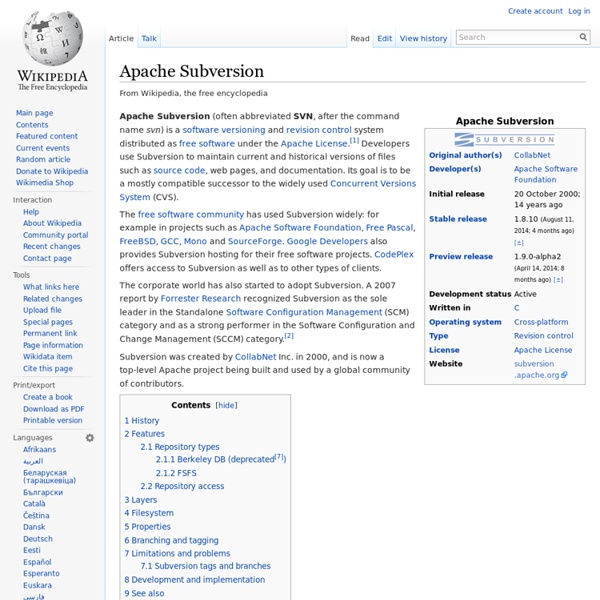Subversion (software)

EtherPad: Realtime Collaborative Text Editing
List of revision control software - Wikipedia, the free encyclop
This is a list of notable software for revision control. Local data model[edit] In the local-only approach, all developers must use the same computer system. These software often manage single files individually and are largely replaced or embedded within newer software. Open source[edit] Client-server model[edit] In the client-server model, developers use a shared single repository. Open source[edit] Proprietary[edit] Distributed model[edit] In the distributed approach, each developer works directly with his or her own local repository, and changes are shared between repositories as a separate step. Open source[edit] Proprietary[edit] BitKeeper – was used in Linux kernel development (2002 – April 2005)Code Co-op – peer-to-peer version control system (can use e-mail for synchronization)Sun WorkShop TeamWare – designed by Larry McVoy, creator of BitKeeperPlastic SCM – by Codice Software, Inc Notes[edit] See also[edit] External links[edit]
AEM0702EU - Targus Portable SpeakerBook USB (AEM0702EU)
Don’t be fooled by its size, the portable speaker book guarantees high quality sound for pure audio pleasure despite its small form factor. It is especially designed for mobility as it folds flat for travel to enhance life on the go. The speaker book is powered by USB or battery and is compatible with any audio source that has a 3.5mm headphone jack. This means it can be connected to laptop computers, MP3 players or CD players and can be used for business presentations, playing music or watching DVDs. This makes the speaker book an ideal companion for audio entertainment whenever you are away on business or holiday. Features:- High-quality sound: New NXT technology delivers full frequency bandwidth for quality sound in a small form factor housing.- Compact design: Foldable and slim making it a must-have for travel.- No hassle setup: Simply powered by USB or battery.- Ease of use: Convenient front access to volume control wheel.
Versionskontrolle mit Subversion
What would happen to you if you stepped into space without a spa
On a space station orbiting Saturn, a man inside a punctured spacesuit swells to monstrous proportions and explodes ( See the movie 'Outland'). On Mars, the eyes of a man exposed to the near-vacuum of the martian atmosphere, pop out of his head and dangle by their optic nerves on the sides of his face (See the movie 'Total Recall'). Enroute to jupiter on the Discovery spacecraft, Astronaut Dave Bowman space walks for 15 seconds with no helmet, and in no apparent pain, succeeds in reentering the Discovery through an open hatch ( See the movie,'2001:A Space Odyssey'). Fortunately, only in science fiction stories do humans ever come into direct contact with the vacuum of space, but these contacts are often portrayed as having horrific consequences. To experience the vacuum is to die, but not quite in the grisly manner portrayed in the movies Total Recall and Outland. If decompression takes 1/2 second or longer, even lung tissue remains intact.
Funky Rugs
BrowserLab - Test web pages in different browsers
Dear BrowserLab customers, When we originally launched BrowserLab as a free service back in 2009, our customers were struggling with testing their web content across desktop browsers and platforms. Since then with the growth of the importance of mobile devices and tablets, the landscape has changed dramatically. If you need to test across multiple desktop browsers, we recommend that you check out BrowserStack and Sauce Labs as two viable alternatives to BrowserLab. 10 hours (600 minutes) of free manual testing time (with no expiration) for up to two concurrent open browsersOnce you’ve used those 600 minutes, your account will revert to a free account which includes 30 minutes per month of free manual browser testingThis limited time offer will remain valid for 30 days from the date of this blog post If you are working on mobile web projects, check out Adobe Edge Inspect. We’d like to thank all of our customers over the years for using and providing input for the Adobe BrowserLab Service.
KeePass Password Safe
Godchecker.com - Your Guide To The Gods. Mythology with a twist!
Related:
Related:



